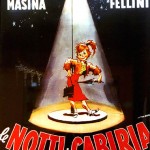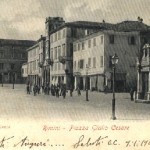As you walk along the lungomare of Rimini, you’ll see that many of the sidestreets carry the names of films by Rimini’s Maestro Federico Fellini – including Via Amarcord, Via Roma, and the wonderfully suggestive Via le Notti di Cabiria. The street signs are accompanied by the original movie posters, making it worth a stroll along that much-neglected side of the beachfront.

Fellini's films, including le notte di cabiria, are now also the names of streets in Rimini
The streets were renamed in the last couple of years – most of them before hand were named after composers like Elgar, Cajkovski, and Schuman for example. The renaming being just another part of the re-integration of Fellini with Rimini. In his lifetime the city had mixed feelings towards this master storyteller, provoked not least of all by the fact that he filmed none of his masterpieces in the town, preferring to recreate the Romagna and Rimini of his youth, for films like Amarcord, in the studios of Cinecitta in Rome.
But it’s not just these streets that have been renamed, giving a glimpse into the way the city changes. Plenty of streets in Rimini have had various names, each change bringing with it a small and intriguing history lesson.

Rimini's Piazza Giulio Cesare - once Piazza San Antonio, and now Piazza Tre Martiri
An obvious example being Piazza Tre Martiri. The square was previously, during the fascist period, called Piazza Giulio Cesare – fittingly enough, given that tradition states that it was from a plinth in the square that the Roman leader gave his famous ‘alea iacta est ‘ (the dice is thrown) speech. The Piazza was renamed after the war to commemorate the three local partisans who were brutally murdered in the square by Nazi-Fascist troops. What is, perhaps, less well known is that prior to being Piazza Giulio Cesare, during the period when Rimini was under the direct control of the Vatican – as part of the Papal states – the square was called Piazza San Antonio, in honour Saint Anthony of Padua. It was, according to tradition, in this central square of Rimini that the Saint performed his famous miracle with the host and a mule. In those three name changes you have a compressed history lesson of the city.
The change of Piazza Fontana to Piazza Cavour is another example, where a simple and functional name was changed over to pay homage, as in most towns throughout Italy, to the bespectacled and bureaucratic hero of the risorgimento Camillo Benso, Count Cavour.
Tags: federico fellini, piazza giulio cesare, piazza tre martiri, rimini under fascism, san antonio
This entry was posted
on Thursday, August 27th, 2009 at 8:49 am
You can skip to the end and leave a response. Pinging is currently not allowed.

